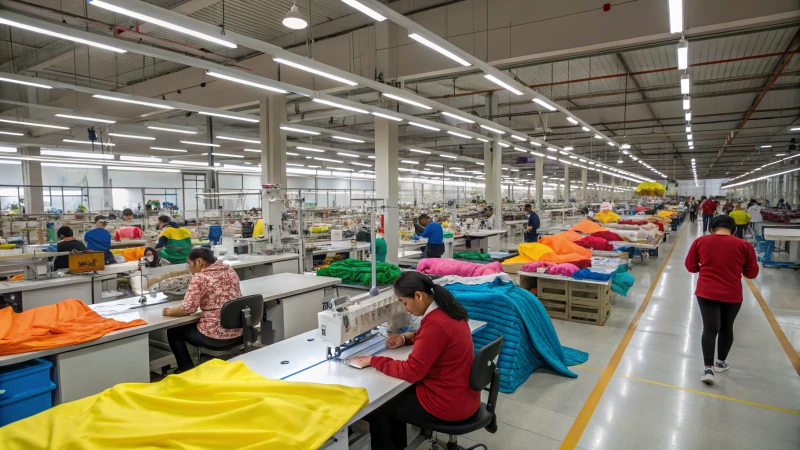
Finding a trustworthy men's underwear supplier is crucial for my business success. Let's dive into the best ways to source quality products!
To find reliable men's underwear suppliers, explore B2B platforms like Alibaba and Made-in-China.com, attend trade exhibitions, and examine product labels for manufacturer details. These methods help identify trustworthy suppliers offering quality products at competitive prices.
While the initial search may seem daunting, employing a strategic approach to sourcing can lead to long-term business success. Keep reading to discover detailed insights into evaluating suppliers and making informed decisions for your business.
B2B platforms like Alibaba offer reliable underwear suppliers.True
Alibaba provides a vast network of verified suppliers, ensuring reliability.
What Are the Best B2B Platforms for Sourcing Underwear?
Finding the right B2B platform can streamline your search for quality underwear suppliers. Let's explore the top platforms for sourcing.
The best B2B platforms for sourcing underwear include Alibaba, Made-in-China.com, and Global Sources. These platforms offer a vast range of suppliers, competitive pricing, and comprehensive filtering options to find the perfect match for your business needs.

Exploring Leading B2B Platforms
When it comes to sourcing underwear through B2B platforms, the choices can seem overwhelming. However, a few stand out due to their extensive reach and reliable supplier network.
Alibaba: Known globally, Alibaba provides an extensive list of suppliers offering a variety of underwear styles. Its user-friendly interface allows businesses to filter suppliers based on location, minimum order quantity, and price range.
Made-in-China.com: This platform is particularly beneficial for those seeking suppliers from China. It offers detailed supplier profiles and a convenient communication tool to negotiate terms.
Global Sources: A trusted platform that connects businesses with verified manufacturers. It is ideal for those looking for quality assurance and strict compliance with international standards.
How to Effectively Use B2B Platforms
Using these platforms effectively requires more than just browsing. Here are some strategies:
Utilize Search Filters: Narrow down your search by specifying material types, production capacity, and preferred certifications.
Assess Supplier Profiles: Evaluate their ratings, customer reviews, and transaction history. Read about evaluating suppliers1 for more tips.
Communicate Clearly: Establishing clear communication is key. Use built-in chat systems to inquire about samples, shipping terms, and customization options.
Comparing Platform Features
Here's a quick comparison of key features across these platforms:
| Platform | Number of Suppliers | Communication Tools | Payment Protection |
|---|---|---|---|
| Alibaba | High | Yes | Yes |
| Made-in-China.com | Medium | Yes | Yes |
| Global Sources | Medium | Yes | Yes |
Choosing the right B2B platform2 can significantly impact your sourcing success. Consider your specific needs and explore each option thoroughly before making a decision.
Alibaba offers a user-friendly interface.True
Alibaba's interface allows filtering suppliers by location and price.
Global Sources has no communication tools.False
Global Sources provides built-in chat systems for supplier communication.
How Can Trade Shows Help in Finding Suppliers?
Trade shows offer a unique opportunity to meet potential suppliers face-to-face, fostering trust and collaboration.
Trade shows help in finding suppliers by providing direct interaction, showcasing product quality, and facilitating networking opportunities. They allow businesses to evaluate suppliers firsthand and build relationships, leading to better deals and understanding of the supply chain.

The Power of Face-to-Face Interaction
One of the most significant advantages of attending trade shows is the opportunity for direct, face-to-face interaction with potential suppliers3. Unlike digital platforms, trade shows allow you to gauge the sincerity, professionalism, and reliability of a supplier through personal contact. This interaction can provide insights into the supplier’s business practices and help build trust more effectively than emails or phone calls.
Evaluating Product Quality Firsthand
At trade shows, suppliers typically showcase their best products. This gives you a tangible way to assess the quality and craftsmanship of the items on display. For instance, if you're in the market for men's underwear, you can examine the fabric, stitching, and design quality directly. This firsthand evaluation ensures that you are partnering with a supplier whose products meet your standards.
Networking Opportunities
Trade shows also serve as a hub for industry professionals, offering extensive networking opportunities. By engaging with other attendees, you can gain insights into industry trends and possibly receive recommendations for reliable suppliers. Networking can also lead to partnerships that might not have been possible through digital correspondence alone.
Access to Competitive Pricing
Meeting multiple suppliers in one location allows for easy price comparison. You can discuss pricing structures directly with suppliers and even negotiate better deals on-site. This competitive environment often leads to more favorable terms than online inquiries might yield.
Understanding Market Trends
Trade shows are often where new trends are unveiled, providing a glimpse into the future of the industry. Attending these events keeps you informed about innovations and shifts in consumer preferences, helping you align your business strategy with market demands. Observing how other companies present their products can also inspire your marketing tactics.
Building Long-Term Relationships
Lastly, trade shows lay the groundwork for long-term supplier relationships. Establishing a rapport during these events can lead to ongoing communication and collaboration, ensuring a stable supply chain for your business. Suppliers often prioritize clients they have met personally at these shows, enhancing your chance of receiving preferential treatment.
In summary, trade shows are invaluable for anyone looking to secure reliable suppliers. By taking advantage of direct interactions, product assessments, and networking opportunities, businesses can strengthen their supply chain strategy effectively.
Trade shows guarantee finding the best suppliers.False
While trade shows provide opportunities, they don't guarantee the best suppliers.
Face-to-face meetings build supplier trust effectively.True
Direct interaction at trade shows fosters trust more effectively than emails.
Why Is Understanding Product Labels Important?
Decoding product labels can reveal crucial information about manufacturing, helping you choose reliable suppliers.
Understanding product labels is vital as they provide essential information about the manufacturer, materials used, and compliance with industry standards. This knowledge aids in assessing product quality and supplier reliability, ensuring that the goods meet your business's requirements and consumer expectations.

Unveiling Manufacturer Details
Product labels often contain valuable information about the manufacturer. By examining labels closely, you can identify where and by whom the product was made. This can be particularly useful when trying to establish direct communication with manufacturers for better pricing or customization options. Investigating these details can lead to discovering new suppliers or confirming the credibility of existing ones.
Assessing Material Composition
Labels provide insights into the materials used in the production of underwear. Knowing the exact fabric composition helps determine the quality, comfort, and durability of the product. This information is crucial for ensuring that the products meet your specific quality standards and are suitable for your target market. For example, if a label indicates a high percentage of cotton, this might suggest a breathable and comfortable garment, which is appealing to consumers.
Compliance and Certification Marks
Product labels often include compliance marks and certifications indicating adherence to industry regulations and standards. Recognizing these marks ensures that the products are safe and meet legal requirements. For instance, labels might include certifications for organic materials or specific safety standards that the products have met. Understanding these certifications can help in choosing compliant products4 for markets with stringent regulations.
Identifying Potential Red Flags
Understanding what’s on a label can also alert you to potential red flags. Inconsistencies or lack of crucial information might suggest issues with authenticity or quality. For instance, if a label lacks clear manufacturer details or misrepresents material composition, it could indicate counterfeit or substandard products. Being vigilant about such discrepancies ensures you avoid unreliable suppliers.
Incorporating these practices into your supplier evaluation process is essential for maintaining product quality and fostering trust with your customers.
Product labels reveal manufacturer details.True
Labels often list the manufacturer's name and location.
All product labels include compliance certifications.False
Not all labels display compliance marks; it depends on the product.
What Factors Should You Consider When Choosing a Supplier?
Selecting the right supplier can make or break your business. What key factors should guide your decision?
When choosing a supplier, consider their reliability, quality control, pricing, communication, and lead times. These factors are essential for ensuring a smooth supply chain and maintaining product standards.

Reliability and Reputation
A supplier's reliability is paramount. Consistent delivery schedules and adherence to promised timelines can significantly impact your business operations. Research customer reviews5 and ask for references from previous clients to gauge a supplier's reliability.
Quality Assurance Processes
Quality control measures ensure that the products meet your standards before reaching the market. Inquire about the supplier's quality assurance processes, such as inspection protocols and quality certifications. Suppliers with established processes often provide superior products6.
Competitive Pricing
While competitive pricing is crucial, it should not come at the expense of quality. Compare pricing across multiple suppliers and consider any additional costs, such as shipping or handling fees. Evaluate if bulk purchasing offers any discounts that could benefit your bottom line.
| Supplier | Base Price | Shipping Cost | Bulk Discount |
|---|---|---|---|
| Supplier A | $5 per item | $50 per shipment | 10% on 100+ items |
| Supplier B | $6 per item | $30 per shipment | 15% on 200+ items |
Communication and Responsiveness
Effective communication is essential for maintaining a strong business relationship. Assess how promptly the supplier responds to inquiries and their willingness to provide detailed information. Good communication ensures that any issues are addressed swiftly and efficiently.
Lead Times and Flexibility
Consider the supplier's lead times—how long it takes for them to deliver products after an order is placed. Suppliers that offer flexibility in lead times can help you adapt to changing market demands without compromising on delivery schedules. Understanding their capacity for scaling production can also be beneficial.
By evaluating these factors, you can choose a supplier that aligns with your business goals and enhances your supply chain efficiency. For further insights, explore our guide on selecting suppliers7.
Supplier reliability impacts business operations.True
Reliable suppliers ensure timely deliveries, crucial for smooth operations.
Quality assurance is unnecessary in supplier selection.False
Quality assurance ensures products meet standards, vital for selection.
Conclusion
By strategically sourcing men's underwear suppliers, businesses can secure high-quality products and achieve competitive pricing.
Understand how to assess supplier credibility effectively.: 3 steps to finding the right suppliers on Alibaba.com · Step 1: Research and verification · Step 2: Communication and negotiation · Step 3: Secure ... ↩
Discover detailed comparisons to choose the best platform.: Examples: Procurify, Precoro, TradeIndia. Besides that, you can find the following among B2B purchasing tools: SRMs, Contract Management, e- ... ↩
Discover how personal meetings at trade shows foster trust and collaboration.: The ability to build personal connections, reach a qualified audience, gain real-time feedback, enhance brand visibility, and maximise ... ↩
Learn about important compliance certifications ensuring product safety and legality.: After an NRTL certifies a product as being compliant with relevant standards, it permits the manufacturer to attach an NRTL mark to the product. ↩
Learn to assess supplier reliability through customer reviews.: One way to do this is by looking at the supplier's track record, checking for any past issues with product quality or delivery times. ↩
Understand essential quality assurance practices in manufacturing.: Quality assurance, or QA, in the context of manufacturing, refers to the processes manufacturers utilize as part of a quality management system ... ↩
Explore comprehensive steps for choosing the right suppliers.: When choosing and negotiating with suppliers, you should consider value for money, quality and reliability in additional to price. ↩






